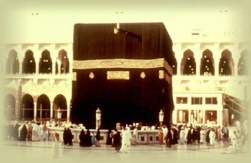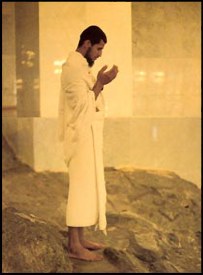ourIslamOnline.net | home
1st Step
The annual Hajj is a strict appointment, beginning the eighth day of the last month on the Muslim calendar. Those who miss the Hajj's central rite--a next day's vigil on the Plain of Arafat, located 12 miles southwest of Mecca--miss the Hajj altogether, although they may return another year.
Sometime before this, every pilgrim traditionally performs a set of rites in the Grand Mosque located in the center of Mecca.
LABEEK
Day One - Pilgrims are easy to pick out, for by now they have showered and changed their street clothes for Hajj garments. For men, these consist of two lengths of white unstitched cotton cloth resembling beach towels. Women wear the usual forms of their national Muslim dress. The clothes are not intended as a means of identification. In fact, they make everyone look alike, which is the point: Everyone is leveled and stripped of obvious social distinctions before entering Mecca, just as everyone is equal before God.
By this time, the vehicles the pilgrims are riding in begin to fill with chanted verses of the Talbiyah, an ancient prayer that when repeated sounds like a "round." An English translation runs, "I am here, God, I am here. I am here because nothing compares to you. Here I am. Praise, blessings, and the Kingdom are yours... (I am here.)" The Talbiyah engages the tongue in the remembrance of Allah. It is the aural signature of the Hajj experience. For the next few days, it can be heard starting up and fading out, anywhere the pilgrims go.
The KA'BAH
 Day One - Regardless of the hour, whether day or night, pilgrims arriving in Mecca go as soon as possible to the Haram mosque. Here they perform an initial set of rites that may last two or three hours. Even on a normally crowded day, it may take a person 15 minutes to reach the center of this building. The goal of the pilgrim at this point is the Kabba; a black-draped cube-shaped shrine of stone blocks about three stories high, with a golden door in one side and, on the roof, a gilded rainspout.
Day One - Regardless of the hour, whether day or night, pilgrims arriving in Mecca go as soon as possible to the Haram mosque. Here they perform an initial set of rites that may last two or three hours. Even on a normally crowded day, it may take a person 15 minutes to reach the center of this building. The goal of the pilgrim at this point is the Kabba; a black-draped cube-shaped shrine of stone blocks about three stories high, with a golden door in one side and, on the roof, a gilded rainspout. The Kabba marks the direction Muslims pray in all their lives. It is the lodestone of Islam and its oldest structure, linked in a tradition reaching back to Abraham. For a Muslim, this shrine symbolizes the unity of God and is often referred to as God's House.
GREETING THE MOSQUE
Day One - The Haram mosque is the only mosque in the world built in the round. Its surrounding prayer halls all face the Kabba, and the whole building is organized around it.
After offering a brief two-part prayer, each pilgrim arriving here sets out at the northeast corner of the building and, in keeping with an ancient tradition, walks briskly seven times around the Kabba. This is a form of walking prayer, valid only in Mecca, called the Turning. The Turning opens a person's heart, unifies the turners, and induces a compassionate point of view. This symbolic circling of God's House is a reminder to keep an awareness of the Sustainer at the center of your life. Pilgrims may perform this rite as often as they like.
Because even people weakened by age want to make their seven circuits, the outermost rim of this human circle is often marked by sets of bearers hoisting a single pilgrim on a litter and carrying him or her around the shrine. The radiant faces of these elders, borne reclining above the crowds, forms one of the early, indelible images a pilgrim carries home.
 The WELL
The WELLDay One - After their final circuit, pilgrims leave the Kabba and approach a flight of steps that leads down to a cavernous room beneath the marble floors. Here lies the source of the ancient Zamzam Well, mentioned first in the Book of Genesis and later in the Psalms.
This well presents a fundamental wonder: water in a desert, the first requirement of urban life. Without it, there would be no Mecca. Its discovery here in ancient times is linked to the biblical story of the Egyptian woman Hagar, mother of Abraham's first child, Ishmael. Water from the Zamzam Well sustained Abraham's lineage in the desert. In keeping with tradition, each pilgrim takes a drink from it, to refresh himself and prepare for the rite that follows.
The RUN
Day One - Like turning around the Kabba, the next Hajj rite is performed on foot. This time the direction is not circular but linear, a series of seven processions between the hills of Safa and Marwa.
These quarter-mile laps symbolize Hagar's search for water for her thirsting son. The message here is of perseverance in the direction of salvation: one keeps on moving, moving, moving. The seventh lap delivers the pilgrim to Marwa and completes the first set of the Hajj rites.